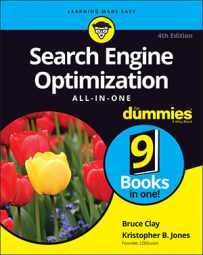Developing an ethical SEO strategy is the best way to ensure that you rank high in search results. Sure, spam might bump your page rank for a little while, but you will be caught, and your site will be penalized or pulled from the index entirely. So why use it?
For too long, many SEO practitioners were involved in an arms race of sorts, inventing technology and techniques in order to achieve the best rankings and get the most clients. Unfortunately, some developed more and more devious technology to trick the search engines and beat the competition. Thus, there are two types of techniques used in SEO:
White hat: This includes all SEO techniques that fall into the ethical realm. White-hat techniques involve using relevant keywords, descriptive Alt attribute text, simple and clear metadata, and so on. White-hat techniques clearly comply with the published intent of the various search engine quality guidelines.
Black hat: Black-hat techniques are sneaky and devious, and they attempt to game the engines to promote content not relevant to the user. These techniques are deceptive and generally break (or at least stretch) the search guidelines, commonly leading to spam penalties that are painful at best and devastating at worst.
With the search engines implementing aggressive antispam programs, the news is out: If you want to get rankings, you have to play well within the rules. And those rules are absolutely “No deception or tricks allowed.” Simply put, honest relevancy wins at the end of the day. All other approaches fade away.
Generally, the search engines all adhere to a code of conduct. Little things do vary from search engine to search engine, but the general principle is the same:
Keywords should be relevant, applicable, and clearly associated with page body content.
Keywords should be used as allowed and accepted by the search engines (placement, color, and so on).
Keywords should not be utilized too many times on a page (frequency, density, distribution, and so on). The use should be natural for the subject.
Redirection technology (if used) should facilitate and improve the user experience. But understand that this is almost always considered a trick and is frequently a cause for penalties or removal from an index.
Redirection technology (if used) should always display a page where the body content covers the expected topic and contains the appropriate keywords (no bait and switch).
You can get back into a search engine’s good graces after getting caught spamming and penalized or yanked out of the index. It involves going through your site and cleaning it up, removing all the spam issues that caused it to get yanked in the first place, and resubmitting your pages for placement into the index. Don’t expect an immediate resubmission, though. You have to wait in line with everyone else.
The search engines tweak their algorithms all the time in a continuous effort to improve the quality of search results. Google has said it makes more than 500 changes a year — that’s more than once per day! Many changes are minor, but others aggressively attack one form of spam or another, causing major consequences for websites trying to rank. When the dust settles, both winners and losers emerge.
Within the SEO industry, any sudden and noticeable demotion in search engine ranking is called a penalty. Penalties can be assigned either manually or as the result of an algorithm change, but the resulting drop in traffic and revenue feels the same to the website owner. Search engines have human quality raters who can review a website and assign a manual action if they find that the site violates their quality guidelines. That’s what search engines call a “penalty.”
But sites can also get hit with an algorithmic penalty when an algorithm change redefines what’s okay to do and they are suddenly caught outside the new stricter boundaries. Just as in musical chairs when the music stops, a site that has been happily playing the game can suddenly find itself without a place to sit in the SERPs.
Google’s major algorithm updates have resulted in massive algorithmic penalties (as well as an arguably much cleaner SERP). For some reason, the updates are usually named after cute black-and-white animals. This table lists the whole menagerie and explains the types of spam tactics or low-quality content each update targets.
| Update | Release Dates | Purpose |
|---|---|---|
| Panda | February 2011; several subsequent updates | Reward quality content and penalize sites with thin or shallow content |
| Penguin | May 2012; periodic updates every 6–12 months | Penalize sites that have link spam or too many low-quality links to a site |
| Page Layout | January 2012 | Penalize sites with too much advertising above the fold |
| Payday Loans | June 2013; two updates in 2014 | Target spammy sites and queries, such as [payday loans], [casinos], [viagra] |
| Pigeon | July 2014 | Improve local search results in Google Maps and web searches |

